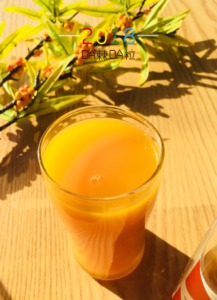Sea buckthorn fruits have a unique flavor that cannot be compared to the flavor of any other berry. As mentioned previously, the chemical composition of sea buckthorn is influenced by several factors, such as genotype, degree of maturity, weather conditions, growth location and latitude, and harvest date and, consequently, the sea buckthorn flavor is conditioned by these factors, too.
Sea buckthorn fruits have a specific scent based on around 45 compounds, including esters, alcohols, aldehydes, ketones, and terpenes. Most  subjects defined this smell with notes of berry or citrus. 43 volatile compounds were identified in sea buckthorn juice by GC—MS analysis. The most abundant derivatives were ethyl esters of 2-methylbutanoic acid, hexanoid acid, methylbutanoic acid, octanoic acid, and butanoic acid, as well as 3-methylbutyl 3-methylbutanoate, 3-methylbutyl 2-methylbutanoate, and benzoic acid ethyl ester.
subjects defined this smell with notes of berry or citrus. 43 volatile compounds were identified in sea buckthorn juice by GC—MS analysis. The most abundant derivatives were ethyl esters of 2-methylbutanoic acid, hexanoid acid, methylbutanoic acid, octanoic acid, and butanoic acid, as well as 3-methylbutyl 3-methylbutanoate, 3-methylbutyl 2-methylbutanoate, and benzoic acid ethyl ester.
The taste of sea buckthorn juice was characterized by sourness, astringency and bitterness, even when varying sugar concentration (from 3.7 to 45.8 g/kg fruits) or titratable acidity (from 23.6 to 46.6 g citric acid/kg fruits).
Ethyl-β-D-glucoside content, which is high in overripe sea buckthorn berries, is a negative factor for the pleasantness of the juice, contributing to the bitter flavor. The bitterness of the juice may be reduced by glucose. The same study showed that flavonol glycosides induce a silky, mouth-drying, and mouth-coating astringent sensation even at very low concentrations and that malic acid and isorhamnetin glycosides were the major compounds responsible for the astringency in sea buckthorn puree.

Leave A Comment